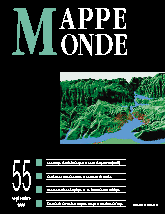

Stéphane Puzin. The Three Gorges dam (China) (8 fig.)
The Three Gorges dam, under construction on the Yangzijiang, will be the world's biggest dam ever. The gargantuan scale and growing western media coverage of the project give an idea of its environmental and human implications. This paper first outlines the main characteristics and consequences of the dam project. It then presents the research work of the GIS team from the Institut de Géographie Alpine (IGA) in Grenoble, whose main aim is to analyse the resettlement of over one million people and to model its demographic and social impacts.
keywords: CHINA, DAM, DENSIFICATION, RESETTLEMENT, SIMULATION
Space and the action of teaching: elements for the chorematics of the classroom (2 fig.)
An education research project aiming to contribute to a theory of the action of teaching has used a concept borrowed from geography: the choreme. This paper explains the approach taken, sets out the results and proposes the chorematics of the classroom.
keywords: ACTION OF TEACHING, CHOREMATICS, CLASS SPACE, CONTEXTUALISATION, PRACTICE OF TEACHING
Laurent Grison. The senses of a museum (3 fig.)
This paper, based on the example of the National Gallery in London, deals with the planning, spatial dynamics and integration of a museum area into the cityscape. On the same theme, it recounts an exercise with secondary school students.
keywords: AUDIO-GUIDE, FLOWS, LONDON, MUSEUM AREA, NATIONAL GALLERY, SPATIAL DYNAMICS, TOWN PLANNING
Water for the poor in Port-au-Prince, Haiti (7 fig.)
The urban growth of Port-au-Prince has led to the proliferation of shantytowns and deterioration of people's living conditions. The public drinking water utility is extremely inefficient and people have had to develop various other ways to obtain water. A project introducing a system of user-pay standposts has been changing the landscape and life of some poor areas. Through the public and community management of this new service, the urban poor are experimenting a means to integration with the city.
keywords: PORT-AU-PRINCE, PUBLIC UTILITY, SHANTYTOWNS, STANDPOSTS, WATER MANAGEMENT
Biodiversity, landscape and territorial planning: from corridors to biological connection zones (3 fig.)
To describe the organisation and structure of animal populations, concepts such as «flows of individuals» and «corridors» are increasingly appealing to territorial managers. However, corridors are determined for particular species and cannot capture all the ecological flows between two habitats. This paper introduces the concept of biological connection zone to describe a functional space of biological exchange.
keywords: ECOLOGY, FAUNA MANAGEMENT, LANDSCAPE, TERRITORIAL PLANNING
Michel Desse. The changing coast of Martinique Island (4 fig.)
A series of cartographical analyses (1955-1994) highlights the changes in the Martiniquan coast. In the north-west of the island, the coast has diminished by 25 m-35 m, through the combined effects of waves and currents and sand quarrying. In the south, in contrast, along the cul-de-sac du Marin, the coast has been extended by up to 30 m, which can be largely attributed to changing trends in land use.
keywords: COAST, PROGRADATION, ENVIRONMENT, EROSION, MARTINIQUE
Tokyo and the countryside: suburban expansion in Toride (2 fig.)
The Japanese periurban space differs from the pattern observed in Europe or the United States. As cities expand, the urban fabric retains agro-rural elements. This paper uses a GIS of two districts in the municipality of Toride, an outlying suburb of Tokyo; it makes it possible to quantify and capture the pace of urban sprawl since 1945. It also shows up the motley and, in some respects, disorganised landscape of Japan's large modern suburbs.
keywords: DESAKOTA, GEOGRAPHICAL INFORMATION SYSTEMS, JAPAN, PERIURBANISATION
Vincent Berdoulay, Hélène Saule-Sorbé. Franz Schrader and Gavarnie, or the geographer turned landscape painter (5 fig.)
The series of paintings produced by the geographer Franz Schrader of Gavarnie in the French Pyrenees offers an opportunity to study the relationships between art and science as far as landscape is concerned. The evolution of Schrader's approach demonstrates a constant search for complementarities.
keywords: FRANZ SCHRADER, GAVARNIE, LANDSCAPE, PAINTING, REPRÉSENTATION
Denise Pumain, Anne Bretagnolle, Melina Degorge-Lavagne. The city and urban growth in space-time (5 fig.)
The historical increase in the speed of travel is changing the properties of the space in which social interaction occurs. The space-time concept makes it possible to delimit geographical objects, such as cities, in a manner that is comparable from one period to another, in terms of the duration of journeys and the ensuing opportunities for interaction, showing up in an urban expansion in space measured in kilometres. An experiment conducted in Valence (south-eastern France) shows some coincidence between the zone accessible within 30 minutes and the space covered by urban and peri-urban growth since the beginning of the 19th century.
keywords: CITY, INTERACTION, SPACE-TIME, URBAN GROWTH
Book reviews. (Philippe Cadène, Laurent Grison)
Mappemonde 2/99![]()
![]() Mappemonde 4/99
Mappemonde 4/99
For subscribe or buy this issue: BELIN
Last modified: April 14, 2000